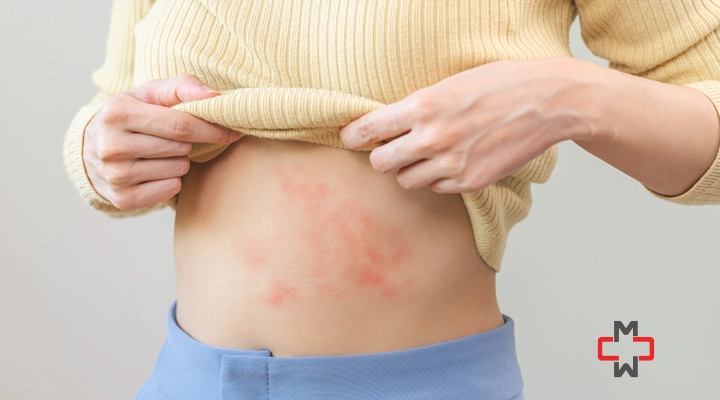A rash on the stomach can be uncomfortable, surprising, and even alarming for many people. It may appear as red patches, bumpy spots, blisters, or itchy welts on the skin of your abdomen, sides, or lower belly. While some stomach rashes go away on their own, others can indicate infections, allergic reactions, or chronic skin conditions that require medical evaluation.
At Manhattan Medical Arts in New York City, Dr. Syra Hanif, our board-certified primary care physician, has years of experience diagnosing and treating a wide range of skin conditions, including stomach rashes. We see patients every week with concerns about rash on stomach—from mild, short-lived irritations to persistent, painful, or spreading rashes that need prompt medical care.
What Does a Rash on the Stomach Look Like?
A stomach rash can take many forms, depending on its cause. It may appear as flat red areas, small red bumps, itchy patches, scaly or dry skin, or even blisters that ooze fluid. Some people experience a rash on the side of stomach, while others see it on the lower stomach—in both male and female patients, these locations can help suggest specific causes.
Sometimes a rash is itchy and intensely bothersome, while other times it is not itchy but still worrisome. It can be bumpy, have red discoloration, or appear as clusters of blisters or welts. Recognizing these patterns is important because it helps your doctor determine the underlying cause.
For example, heat rash on stomach often shows as small, pinkish bumps that develop in hot, humid weather due to blocked sweat ducts. Meanwhile, stress rash on stomach typically manifests as itchy, red welts or hives that come and go, especially during periods of emotional tension.
Causes of Rash on Stomach
There are many possible causes of rash on abdomen or stomach, and identifying them is the first step to effective treatment.
Allergic reactions are common culprits. Substances such as soaps, detergents, fragrances, nickel, or latex can trigger contact dermatitis, resulting in red, itchy, swollen skin. Certain foods or medications can also provoke widespread hives or welts.
Infections are another major cause. Bacterial infections like impetigo or cellulitis can cause red, tender, sometimes oozing rashes. Viral infections—including chickenpox, shingles, measles, and rubella—often produce distinctive rashes that may involve the stomach. Fungal infections like ringworm create circular, scaly, red patches, while parasitic infestations like scabies cause intensely itchy, pimple-like clusters.
Autoimmune conditions can lead to persistent rashes. Eczema (atopic dermatitis) causes dry, flaky, itchy patches that often worsen with environmental triggers. Psoriasis results in thick, scaly, red areas. Lupus and vasculitis can also involve the skin with rashes that may appear on the abdomen.
Other factors include heat rash, which is common in hot weather and characterized by small, itchy bumps; pregnancy-related rashes such as PUPPP (Pruritic Urticarial Papules and Plaques of Pregnancy), which cause itchy red lesions along stretch marks; drug-induced rashes from medications such as antibiotics or anticonvulsants; and stress, which can trigger hives or exacerbate existing skin conditions.
Our team at Manhattan Medical Arts has extensive experience identifying these causes, using our collective knowledge to guide effective, personalized treatment plans.
Symptoms of Stomach Rash
Symptoms of rash on stomach can vary widely. Patients often describe itchy rash on stomach, with varying levels of discomfort—from mild irritation to severe, sleep-disrupting itch. The rash might appear as red bumps on stomach, flat patches, blistering lesions, or scaly, flaky skin.
Some people notice rash on stomach not itchy—these can be medication-induced or due to mild irritation. Others might experience rash on lower stomach female or rash on lower stomach male areas, which can help pinpoint causes like heat rash, PUPPP, or contact dermatitis from belts, waistbands, or topical products.
Pain, swelling, warmth, and oozing fluid suggest possible infection. Systemic symptoms like fever, fatigue, or swollen lymph nodes may indicate an underlying infectious or inflammatory process that needs medical evaluation.
How Can I Identify My Rash?
Identifying your rash starts with careful observation. Note the appearance: Is it red, bumpy, scaly, blistered? Look at the location—is it on your side, lower belly, around the navel? Track symptoms like itching, pain, burning, or swelling. Consider recent exposures: Have you used new soaps, lotions, detergents, or worn tight clothing? Have you spent time in heat or humidity, or felt stressed?
Also, think about systemic symptoms. Fever, joint pain, fatigue, or respiratory symptoms alongside a rash may suggest an infection or autoimmune cause.
At Manhattan Medical Arts, Dr. Syra Hanif takes time with patients to go through these details carefully, helping pinpoint the underlying cause and design an effective treatment plan.
Diagnosis and Testing
Diagnosing a rash on belly or abdomen often begins with a thorough medical history and physical exam. Dr. Hanif and our team may ask about recent activities, exposures, medications, and associated symptoms.
Testing can include:
- Skin swabs or cultures to identify bacterial or fungal infections.
- Skin biopsy to examine rashes with unclear causes or suspected autoimmune conditions.
- Blood tests to check for signs of systemic inflammation, infection, or autoimmune disease.
- Allergy testing if an allergic trigger is suspected.
These tests provide important results that help confirm the diagnosis and guide treatment.
✅ We offer comprehensive evaluation and testing at Manhattan Medical Arts Primary Care for patients with unexplained rashes.
Treatment for Rash on Stomach
Treatment depends entirely on the underlying cause. For allergic reactions, we may recommend avoiding triggers, using over-the-counter antihistamines like cetirizine (an FDA-approved option), and applying topical corticosteroids to reduce inflammation.
Infections require targeted therapy. Bacterial rashes like impetigo may need topical or oral antibiotics, following CDC guidelines for strep infections. Fungal infections such as ringworm respond to antifungal creams like clotrimazole. Viral rashes often need supportive care, though antivirals are used for shingles.
Autoimmune conditions such as eczema or psoriasis benefit from prescription corticosteroids, immunomodulators, and consistent moisturizing with hypoallergenic emollients.
Heat rash on stomach often resolves with cool compresses, breathable clothing, and avoiding overheating. Stress rash on stomach can improve with stress-reduction techniques and antihistamines for symptomatic relief.
✅ At our clinic in Manhattan, Dr. Syra Hanif tailors treatment plans for each patient, combining medical management with lifestyle advice to prevent recurrences.
Home Remedies and Prevention
Managing a rash on abdomen at home often starts with gentle skin care. Use fragrance-free soaps and moisturizers. Keep the area clean and dry, and avoid hot showers that can dry or irritate skin.
Wear loose, breathable clothing to reduce friction, especially important for heat rashes and contact dermatitis. Avoid scratching the rash to prevent infection—keep fingernails short and clean.
Identify and eliminate triggers such as new detergents, skincare products, or stressful situations. Stay hydrated and consider relaxation techniques like deep breathing or mindfulness to reduce stress-related flares.
✅ If your rash is persistent or severe, don’t hesitate to seek professional care. We’re here to help you find lasting relief.
When to See a Doctor
Most mild rashes improve with basic care, but seek medical attention if:
- The rash is painful, spreading quickly, or oozing pus
- You have signs of infection like warmth, redness, and swelling
- It persists for more than two weeks without improving
- It comes with systemic symptoms like fever, fatigue, or joint pain
- You suspect a drug reaction or allergic response
Call 911 immediately if you experience:
- Swelling of the face, lips, or throat
- Difficulty breathing or wheezing
- Confusion, lightheadedness, or loss of consciousness
- A rapidly spreading purple rash
Your health and safety are our priority at Manhattan Medical Arts.
Book Your Appointment Today
If you’re dealing with a rash on stomach, don’t wait. Get expert, compassionate care at Manhattan Medical Arts.
👉 Book Your Walk-in, Online, or Virtual Appointment Now
Frequently Asked Questions
How do you tell if a rash is from a virus?
Also commonly known as measles rashes, the rashes are usually red in color and can manifest in several spots or patches; patients experiencing viral rashes may have fever, fatigue or respiratory symptoms. The development of patterns differs according to the particular virus; professional medical help should be sought for a proper identification of the virus.
How long does a viral rash last?
Usually, viral rashes take their time and may range from several days to about a week and two. However, if the rash lasts to two weeks or if it becomes worse, seek the services of a doctor.
What stomach problems cause rashes?
Some patients having skin rash include those with celiac diseases, liver diseases such as hepatitis and inflammation of the bowel. Some of the examples are dermatitis herpetiformis, itching due to jaundice and erythema nodosum.
When to worry about a rash in adults?
Contact doctor if you are experiencing rash and you have some severe symptoms such as shortness of breath, swelling, have a rash that lasts for more than 2 weeks, rash with signs such as joint pain, severe tiredness or changes in consciousness.
References
- CDC: Skin Infections
- NIH: Atopic Dermatitis
- Mayo Clinic: Rash Treatments
- Johns Hopkins Medicine: Rash Causes
Disclaimer
This blog is for informational & educational purposes only and does not intend to substitute any professional medical advice or consultation. For any health-related concerns, please consult with your physician, or call 911.
-
About The Author
Dr. Syra Hanif M.D.Board Certified Primary Care Physician
Dr. Syra Hanif is a board-certified Primary Care Physician (PCP) dedicated to providing compassionate, patient-centered healthcare.
Read More







